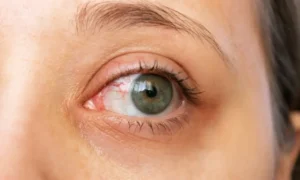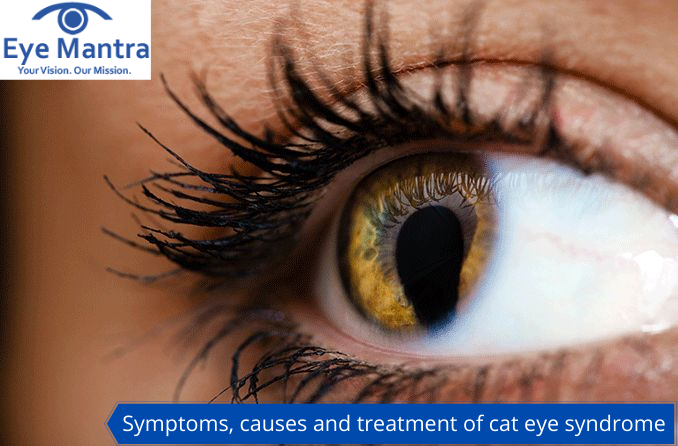Cat Eye Syndrome, is a rare genetic condition that sparks curiosity and concern alike. Ever heard of it? Named for the distinctive eye shape some people with the condition have, it’s more than just about the eyes.
In this blog, we’re diving deep into what Cat Eye Syndrome is all about. We’ll cover the symptoms that range from the obvious to the less known, explore what causes it, answer your big question—can it affect your vision?—and discuss the treatment options available. So, whether you’re looking to understand the condition better or seeking information for someone close to you, read on!
Contents
Understanding Cat Eye Syndrome
Cat Eye Syndrome is a rare genetic condition, known for its distinctive chromosomal characteristics. This syndrome is a chromosomal disorder resulting from a duplication or trisomy of a part of chromosome 22.
The name “Cat Eye Syndrome” comes from one of its most recognizable signs—a peculiar eye shape that resembles a cat’s eye. This is due to a coloboma, a key feature of the syndrome, which occurs when normal tissue in or around the eye is missing.
Beyond the eye-related symptoms, Cat Eye Syndrome can affect multiple systems in the body. Individuals may experience a wide range of abnormalities in the eyes, ears, heart, kidneys, and skeletal system.
Understanding the genetic background of Cat Eye Syndrome is crucial for comprehending its diverse impacts. Currently, there’s no known method to prevent the chromosomal change that causes Cat Eye Syndrome, making awareness and early diagnosis vital for managing its symptoms and improving the quality of life for those affected.
Symptoms
Here are some of the primary symptoms associated with Cat Eye Syndrome:
Presence of colobomas, which are gaps or notches in one or both eyes’ structures, often giving the iris a keyhole or cat-like appearance.
Eye-related issues may include vision problems, strabismus (crossed eyes), and, less frequently, total blindness.
Ear Abnormalities may include malformed ears, experiencing hearing loss.
Kidney Issues such as abnormalities in kidney shape or function, underdeveloped kidneys (renal hypoplasia), or have unusual structures, which can lead to urinary tract infections and other kidney-related health concerns.
Heart Defects such as atrial or ventricular septal defects (holes in the heart).
Skeletal Anomalies: Some affected individuals may exhibit skeletal anomalies including abnormal vertebrae, rib anomalies, and scoliosis.
Facial Features: Distinctive facial features may include a small jaw (micrognathia), wide-set eyes (hypertelorism), and low-set ears.
Anal and Genital Anomalies: Some individuals may have abnormalities involving the anal region, such as an imperforate anus, and genital anomalies can occur in both males and females.
Developmental Delays and Intellectual Disability: While not universal, some individuals with Cat Eye Syndrome may experience developmental delays and varying degrees of intellectual disability.
Causes Behind Cat Eye Syndrome
Cat Eye Syndrome is caused by a genetic mutation involving chromosome 22. Specifically, the condition is most commonly associated with a partial trisomy or duplication of a segment of this chromosome.
However, the exact mechanisms by which this overexpression causes the specific features of the syndrome are not fully understood.
The occurrence of chromosome 22 duplication is usually random, meaning it can happen in any pregnancy without a clear cause. Most cases of Cat Eye Syndrome are not inherited from the parents but occur as a new (de novo) genetic event. However, in rare instances, the chromosomal change responsible for the syndrome can be passed from an affected parent to their child, leading to hereditary cases of Cat Eye Syndrome.
Some Other Names of Cat Eye Syndrome
Here are some of the other names by which Cat Eye Syndrome is known:
- Schmid-Fraccaro Syndrome
- CES (Chromosome 22 Inversion Duplication)
- Partial Tetrasomy 22
- 22q11.2 Duplication Syndrome
Does Cat Eye Syndrome Affect Vision?
 The short answer is yes, CES can affect vision, but the extent and nature of the impact vary significantly among those diagnosed with the syndrome.
The short answer is yes, CES can affect vision, but the extent and nature of the impact vary significantly among those diagnosed with the syndrome.
Impact on Vision:
Colobomas and Vision: The effect of a coloboma on vision depends on its location and size. Iris colobomas may have a minimal impact on vision, while colobomas affecting the retina or optic nerve can lead to significant visual impairment, including vision loss in severe cases.
Other Vision Issues: Beyond colobomas, individuals with CES may experience a range of other vision-related issues. These can include strabismus (misalignment of the eyes), nystagmus (involuntary eye movements), and nearsightedness or farsightedness. Each of these conditions can affect an individual’s visual acuity and quality of life.
Variability Among Individuals: Some individuals may have mild or no noticeable vision impairments, while others may require corrective lenses, surgery, or other interventions to manage more significant vision challenges.
Treatment
Cat Eye Syndrome (CES) is a complex condition with a wide range of symptoms affecting various parts of the body. Because of its diverse nature, treatment and management strategies for CES are highly individualized, focusing on addressing the specific symptoms and challenges each person faces. Here’s an overview of some common treatment and management approaches for CES:
Management of Vision Problems
For individuals with vision impairments due to colobomas or other eye-related anomalies, treatment may include:
- Corrective Lenses: Glasses or contact lenses to correct refractive errors like nearsightedness or farsightedness.
- Surgical Interventions: In some cases, surgery may be necessary to address structural issues within the eye or to correct strabismus (misaligned eyes).
- Low Vision Aids: For those with significant vision loss, tools and technologies designed to enhance remaining vision can be helpful.
Hearing Support
For individuals with hearing loss or ear abnormalities, treatments may involve:
- Hearing Aids: Devices to amplify sound for those with hearing impairment.
- Surgical Correction: Procedures to correct structural anomalies of the ear that may contribute to hearing loss.
Heart Defect Management
Congenital heart defects common in CES may require:
- Medication: To manage symptoms or complications related to heart anomalies.
- Surgical Repair: In some cases, corrective heart surgery may be necessary to fix structural defects.
Kidney Function Monitoring
Regular monitoring of kidney function is crucial for individuals with renal anomalies. Treatment may include:
- Medications: To address urinary tract infections or other kidney-related issues.
- Surgical Procedures: For severe structural problems of the kidneys or urinary tract.
Developmental Support
Developmental delays and learning difficulties may require:
- Early Intervention Services: Such as speech therapy, occupational therapy, and special education programs to support developmental milestones and learning.
- Behavioral Therapy: To address any behavioral issues or social skill development needs.
Skeletal Anomalies Management
Physical therapy or surgical interventions may be needed to manage skeletal issues like scoliosis or abnormalities of the vertebrae and ribs.
Addressing Anal and Genital Anomalies
Surgical correction may be necessary for abnormalities in the anal and genital regions to ensure proper function and reduce the risk of complications.
Genetic Counseling: Offering support and information to families affected by CES, including discussions about the genetic nature of the syndrome and the risk of recurrence in future pregnancies.
Individuals with CES and their families need to work closely with a team of healthcare providers, including geneticists, ophthalmologists, cardiologists, and other specialists, to develop a comprehensive treatment plan tailored to their unique needs.
Conclusion
Struggling with eye conditions can be daunting, but you don’t have to face it alone. If you’re experiencing any eye-related symptoms, don’t let them escalate. Take the first step towards clearer vision and better eye health today. Visit the Best Eye Hospital in India for expert care tailored to your needs.
Book your free appointment now! Give us a call at +91 9711116605 and let us help you see the world more clearly.



